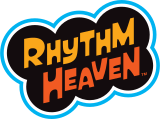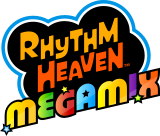Rhythm Heaven Fever

|
Rhythm Heaven Fever (Japanese: みんなのリズム天国 Minna no Rhythm Tengoku in Japan or Beat the Beat: Rhythm Paradise in Europe and Australia), is a visual music game developed by Nintendo and TNX for the Wii. It is the second (third in Japan) game in the Rhythm Heaven series, following Rhythm Tengoku for the Game Boy Advance and Rhythm Heaven for the Nintendo DS. The game was released in Japan on July 21, 2011, in North America on February 13, 2012, in Europe on July 6, 2012, in Australia on September 13, 2012, and in South Korea on September 12, 2013.
N/A
N/A
Gameplay
Like previous titles, the game features various levels with their own set of rules, requiring the player to play in time to the rhythm in order to clear them. These levels range from stabbing peas with a fork, to attacking evil spirits with a sword and playing badminton in midair. Unlike the previous game, Rhythm Heaven, which utilized the features of the Nintendo DS, Rhythm Heaven Fever for the Wii is limited to button controls. The game is played with the Wii Remote held vertically, with players required to either tap the A button, or squeeze the A and B buttons together. At the end of each level, players are ranked on their performance, with at least an 'OK' rank required to clear the level and progress onto the next. Each set of levels culminates in a Remix stage, which combines all the gameplay elements of the previous levels in one stage.
Clearing levels with a Superb/High Level rating earns medals which unlock extra content, including Rhythm Toys, Endless Minigames and levels from the original Rhythm Tengoku. Levels that have been cleared with a Superb rating may also be randomly selected for a Perfect attempt, in which the player can try to clear the level without making any mistakes with the maximum of 3 retries before the perfect challenge disappears. Clearing these unlock bonus items such as songs, lyrics and some rare Props.
New to the series (bar the arcade version of Rhythm Tengoku) is a multiplayer mode, in which two players can play simultaneously. Levels played in multiplayer require players to earn enough points in total to reach the desired rank and clear each stage, with bonus points awarded based on the harmony of the players. These can sometimes result in the rank going from an 'OK' to a 'Superb'.[1] These levels come with their own set of medals which can unlock multiplayer minigames. There are Props that every character in the game can wear. They are earned by playing Rhythm Games, getting medals and clearing the Perfect attempt.
Development and Localization
Producer Yoshio Sakamoto and Nintendo SPD Group No.1 were responsible for the programming, graphic design, and some of the music in the game. Collaborator and musician Tsunku and his music studio TNX created several of the performed vocal songs found throughout the game. In the English versions of the game, an endless minigame based on manzai routines was removed due to the dialogue focused nature of the game and replaced with another minigame from Rhythm Tengoku known as Mr. Upbeat.[2] [3] The European and Australian version of the game allows players to switch between English and Japanese versions of the soundtrack.[4]
List of Rhythm Games
Post-Credits
Clearing the first seven remixes and credits unlocks the following:
| Samurai Slice 2 | Working Dough 2 | Built to Scale 2 | Fan Club 2 | Remix 8 |
|---|---|---|---|---|
| File:Samurai Slice 2 title.PNG | File:Working Dough 2.PNG | File:Built to Scale 2 Wii.PNG | File:Double Date 2.PNG | File:Remix 8 Wii.PNG |
Reception
The game sold over 100,000 copies in its first week in Japan[5] while by the end of the year, it sold a total of over 600,000 copies[6] making it the best selling game of the series. and received a score of 32/40 in the Famitsu[7] magazine.
Trivia
- This game has multiple cameos and callbacks to the original Rhythm Tengoku including cameos and even the returning four bonus games.
- This game was released in Japan nearly five years after the game came out.
- This game is the only game in the series to get a PEGI rating of 7 for violence.
- This is the only game to not have rhythm cues in French, Spanish, German and Italian.
- In the Korean version, it uses a mix between English (Screwbot Factory, See-Saw, Air Rally, Catch of the Day and Bossa Nova) and Japanese (Cheer Readers and Donk-Donk) cues with English songs along with Korean cues for games like Flipper-Flop, Figure Fighter, Ringside, Packing Pests, Board Meeting, Love Rap and Shrimp Shuffle.
- This is currently the only Rhythm Heaven game to have one game cut out for overseas releases.
- This is the only game to not have Drum or Guitar mode.
See Also
References
- ↑ http://www.nintendo.co.jp/wii/somj/norinori/index.html
- ↑ http://iwataasks.nintendo.com/interviews/#/wii/rhythmheavenfever/0/3
- ↑ http://www.youtube.com/watch?v=pi9wrpbwfa4
- ↑ http://www.nintendoworldreport.com/news/29925
- ↑ http://www.andriasang.com/e/blog/2011/07/28/media_create_sales/
- ↑ http://gamerant.com/japan-best-selling-games-2011-jeff-125733/
- ↑ http://www.1up.com/news/japan-review-check-rhythm-heaven

|
| Rhythm Heaven Series | |||
|---|---|---|---|

|

|

|

|
| 2006, GBA • 2007, Arcade | 2008-2009, DS | 2011-2012, Wii • 2016, Wii U | 2015-2016, 3DS |